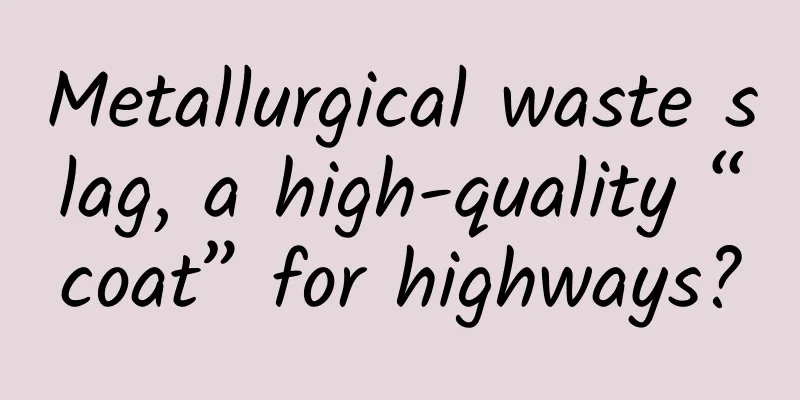Metallurgical waste slag, a high-quality “coat” for highways?

|
Author: Li Chuanfu Shi Xiangqi As environmental awareness grows, how to transform industrial by-products into valuable resources has become an important topic of scientific and technological innovation. The innovative achievement introduced in this article is how to transform metallurgical waste slag, especially steel slag, into high-quality fabrics for highways. This achievement won the first prize of Shanghai Science and Technology in 2023. In the steelmaking process, in order to remove impurities such as silicon, oxygen, carbon, phosphorus, and sulfur in the molten steel, a large amount of solvents such as lime need to be added. These limes react with impurities to form waste residues that float on the surface of the molten steel, which we call steel slag. Steel slag is a by-product of the steelmaking process, with an annual production of more than 150 million tons. 70% of steel slag is stored and discarded as industrial solid waste, with a total of more than 1.8 billion tons, which not only wastes resources, but also occupies soil and pollutes the environment. Since the free calcium oxide (f-CaO) contained in steel slag reacts slowly with water and is wrapped by the steel slag, it is difficult to completely release and hydrate during the treatment process. This affects the volume stability of the steel slag and becomes a key factor restricting its resource utilization. The research and development team led by Xiao Yongli, chief researcher of Baoshan Iron & Steel Co., Ltd., in collaboration with Wuhan University of Technology and other institutions, has developed a technology for converting steel slag into high-quality aggregates through in-depth research on the physical and chemical properties of steel slag. This technology uses a drum-type steel slag treatment process with rapid cooling + mechanical stirring. Through rolling metal balls to crush rapid cooling, multi-point spray fine cooling and online separation and sorting methods, the molten steel slag is rapidly cooled from 1600°C to below 100°C and crushed into particles below 15mm. This process not only effectively inhibits the precipitation and hydration of f-CaO, but also reduces the grain size of steel slag by about 30%. The resulting steel slag aggregate has a uniform natural particle size, meets the aggregate grading requirements, and has stable performance. Compared with traditional natural stone, steel slag aggregate has advantages such as multiple edges and corners, stable volume, and strong bonding with asphalt. Since steel slag is an alkaline material, it is more firmly bonded with acidic asphalt, which makes the road performance of steel slag asphalt pavement materials surpass that of traditional asphalt pavement in many aspects. This technology not only solves the environmental pollution problem of steel slag, but also realizes the efficient use of resources. More than 150 million tons of steel slag are produced every year, and 70% of them are stored and discarded as industrial solid waste. Through this technology, these waste slags can be converted into high-quality aggregates for road construction and daily maintenance, replacing the increasingly scarce natural stone. In addition, this technology can also help reduce carbon emissions and support the green development and carbon neutrality of the two major industries of steel and transportation. The research and development team of Baoshan Iron & Steel Co., Ltd. successfully transformed metallurgical waste slag into high-quality fabric for highways through innovative scientific and technological means. This achievement not only solved environmental problems, but also maximized economic benefits. This technology has been successfully applied not only in Shanghai, but also in highway construction in Hubei, Guangxi, Inner Mongolia and other regions with different climates. More than 3,000 kilometers of highways have been built, 30 million tons of steel slag asphalt concrete have been applied, and carbon emissions have been reduced by 1.98 million tons. This scientific and technological innovation has provided strong support for the advancement of slag treatment technology in the global steel industry and also provided new ideas for achieving sustainable development. |
<<: Sapodilla? It sounds scary. Do you dare to eat it?
Recommend
A two-month-old baby was nearly amputated! The culprit turned out to be a hair. These little things can't be ignored
Audit expert: Mao Xinmei Chief Physician of Pedia...
Wearing the same clothes is not a big deal, but whoever is ugly will be embarrassed! Okapi is very embarrassed
We have counted many animals wearing the same clo...
Did Newton ever get hit on the head by an apple?
Before the 17th century, the mainstream view in E...
The 2017 Internet Marketing Vocabulary, a must-have for Internet people! !
This is a major update to the internet marketing ...
Guangdong University Rankings 2019, which undergraduate universities are there in Guangzhou?
Which universities in Guangdong Province are amon...
What do you think if the next generation iPhone keeps the big bangs design?
At the beginning of last month, Apple officially ...
The latest Baidu promotion and traffic diversion skills in 2021, you can learn them in minutes
We have always said that traffic is the core of I...
Tesla Model 3 mass production is ahead of schedule. Will 20,000 units per month be enough by the end of the year?
After Model S and Model X, the entry-level Model 3...
Why is WeChat far less profitable than Facebook?
An interesting data is that in the third quarter ...
Introduction to OPPO App Store Information Stream Ads
FAQ - Information Stream Advertising Advertising ...
Large-screen TVs have become popular with 4K resolution, so why can’t Chinese people use it?
As early as 2013, major TV manufacturers have suc...
China Automobile Dealers Association: December 2022 automobile retail sales ranking report
According to the latest retail sales data from th...
What is it like to be at the scene of a volcanic eruption?
Perhaps you have seen videos showing volcano enth...
Fainted in the toilet: 60% of Internet practitioners earn less than 6,000 yuan a month
[[134144]] "Working is so tiring, I don'...









